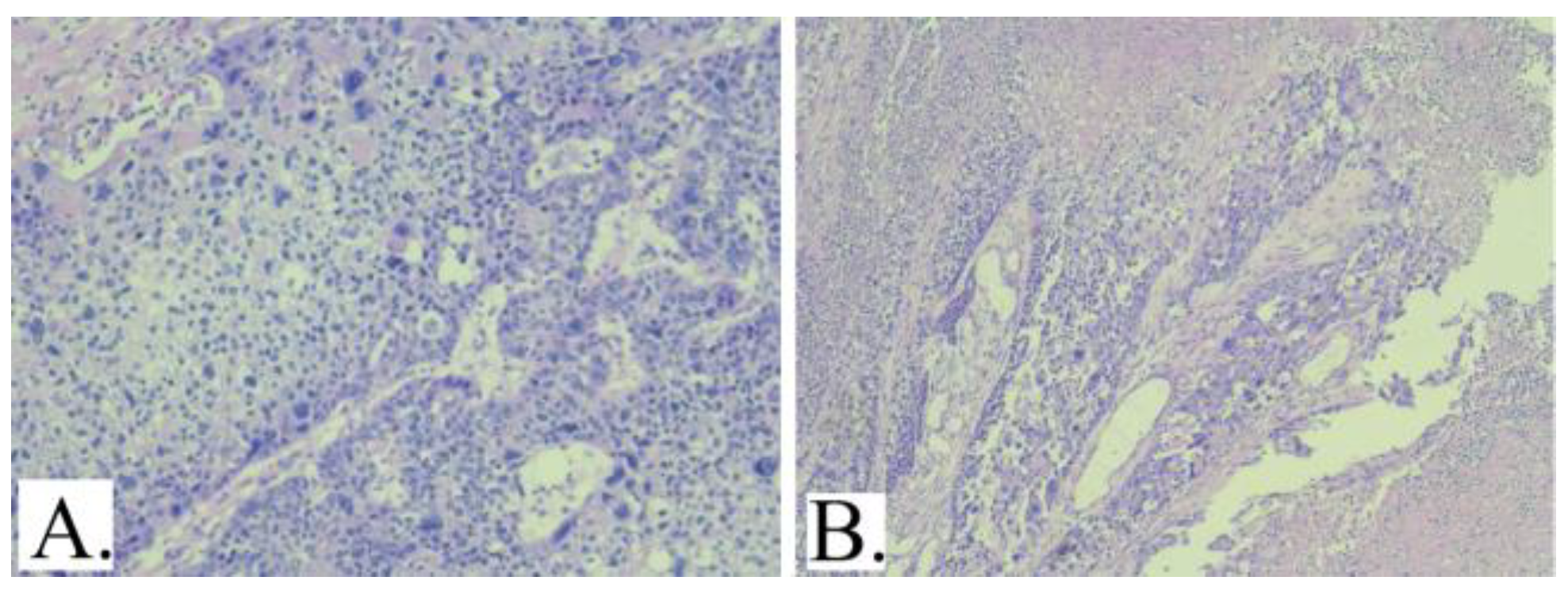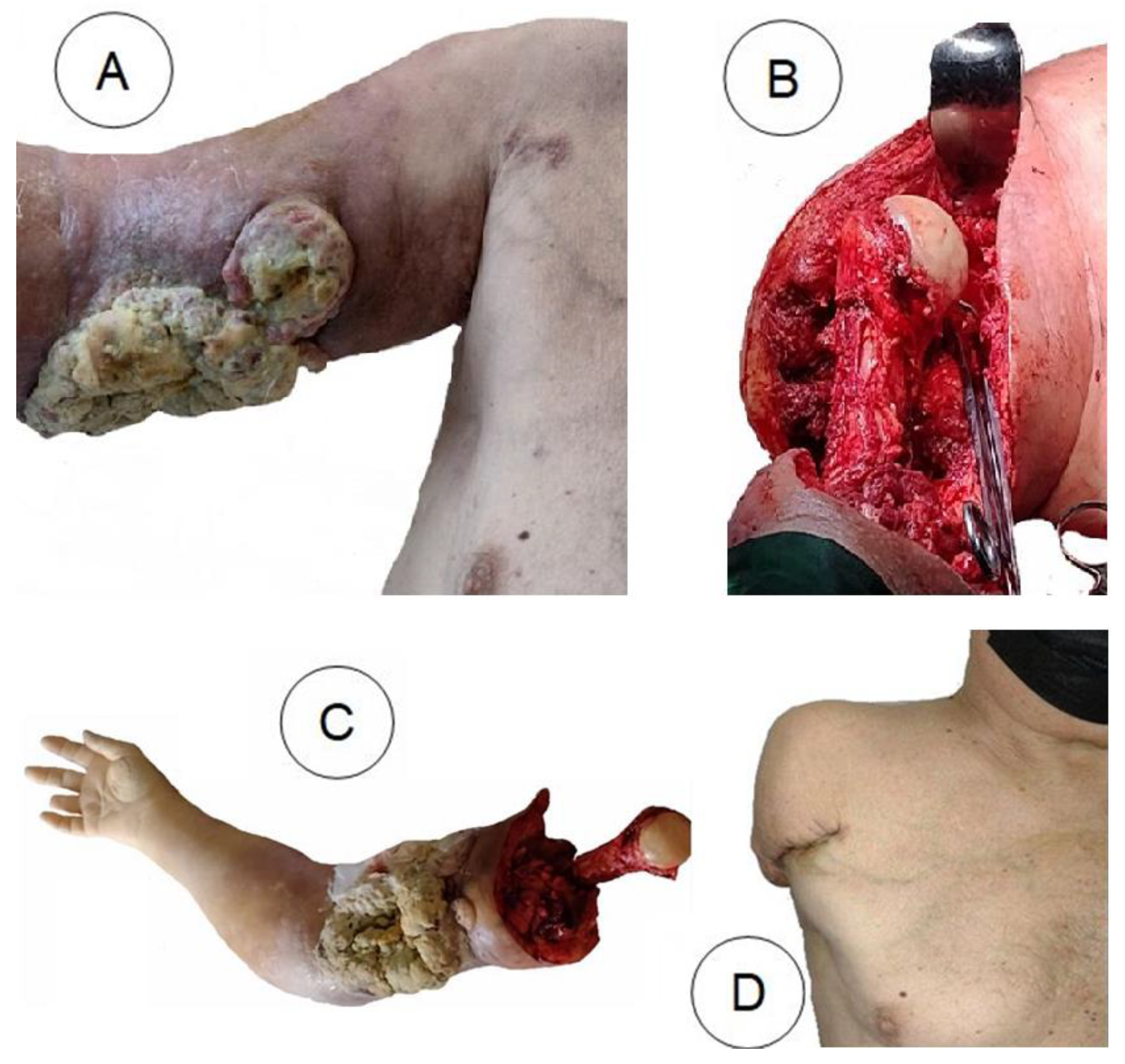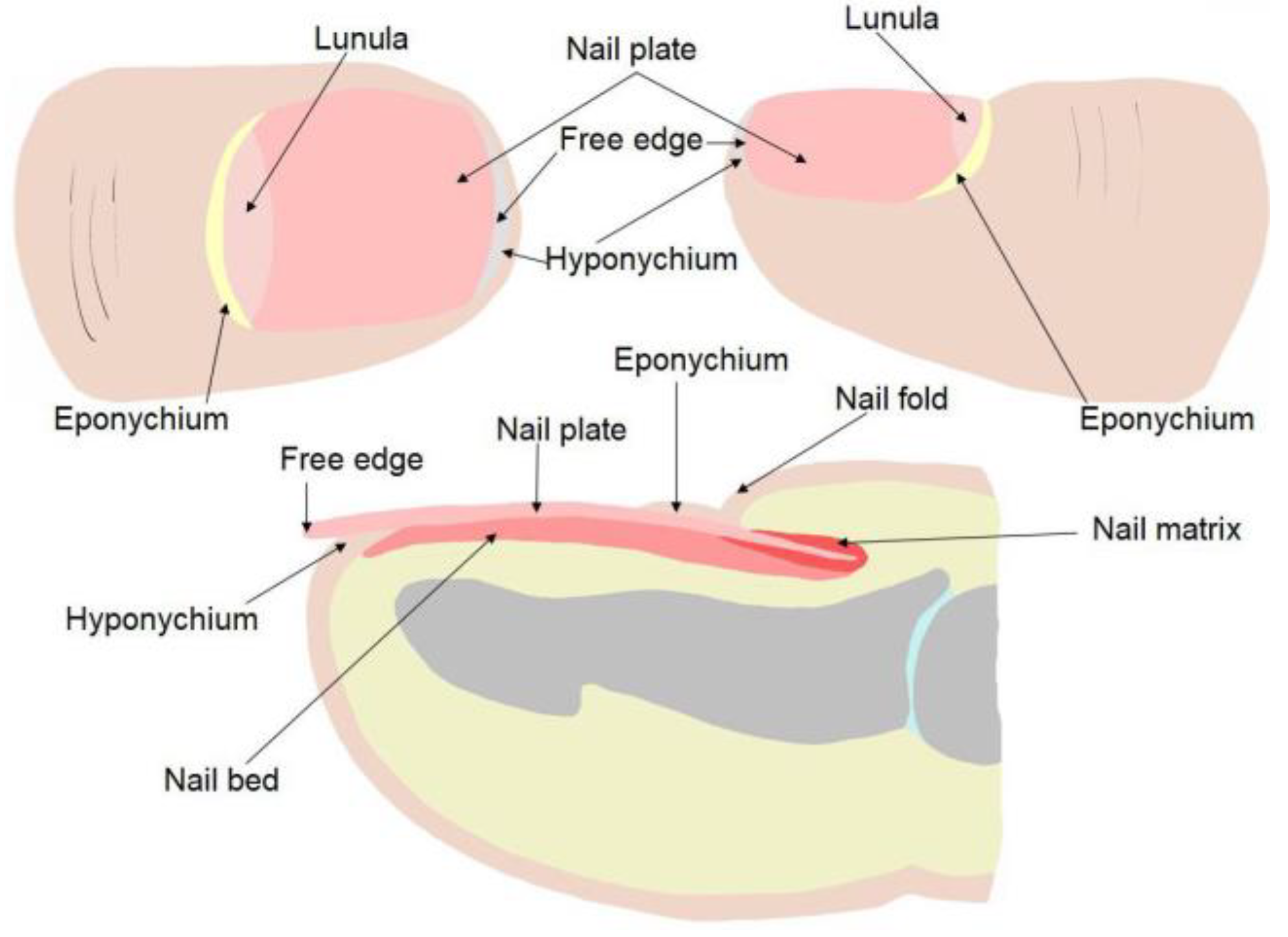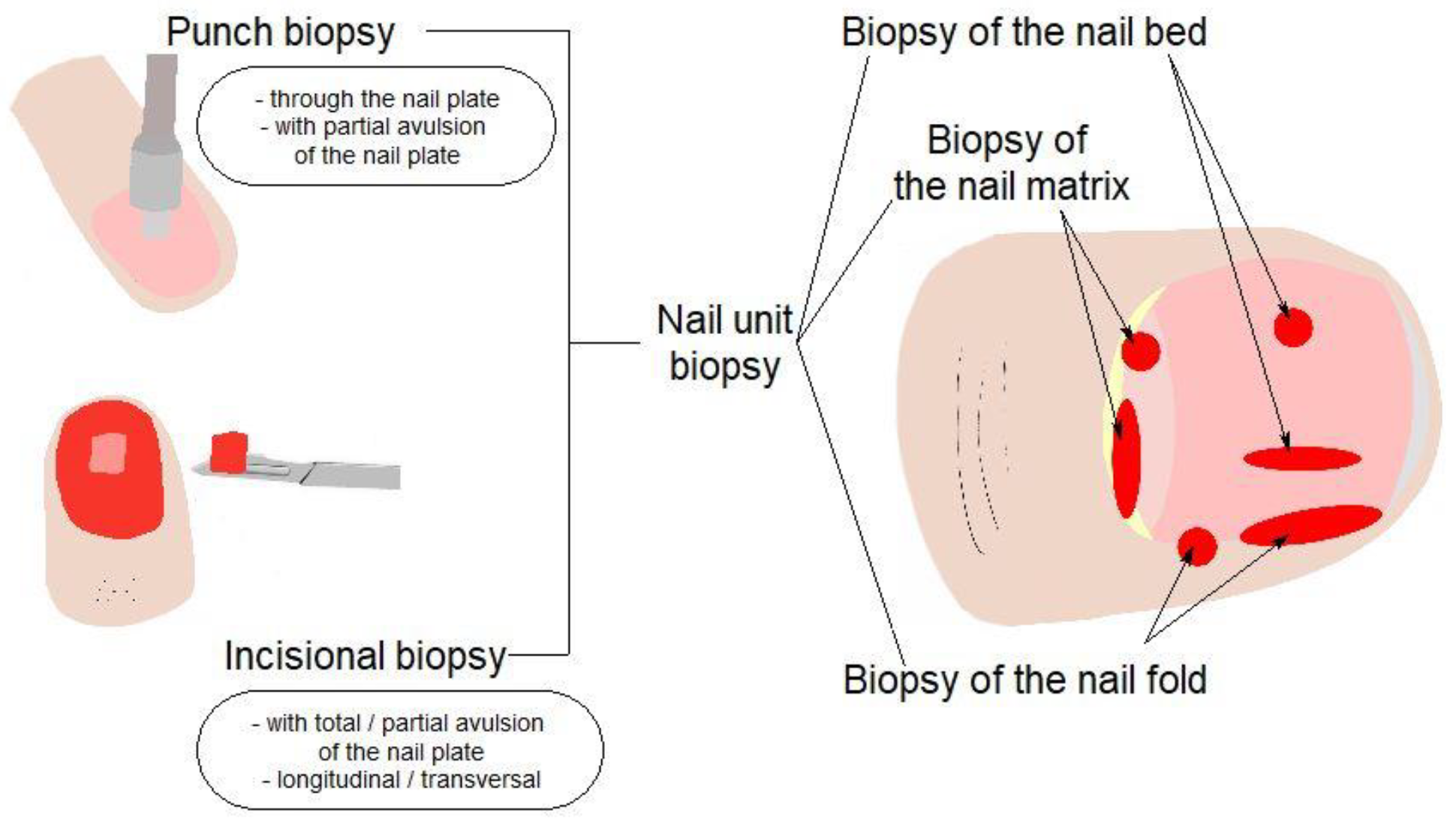Subungual Squamous Cell carcinoma Leading to Arm Amputation
Abstract
:Introduction
Case Presentation
Discussions
Conclusions
Compliance with ethical standards
Conflict of interest disclosure
References
- Starace M, Alessandrini A, Dika E, Piraccini BM. Squamous cell carcinoma of the nail unit. Dermatol Pract Concept. 2018, 8, 238–244. [Google Scholar] [CrossRef]
- Dijksterhuis A, Friedeman E, van der Heijden B. Squamous Cell Carcinoma of the Nail Unit: Review of the Literature. J Hand Surg Am. 2018, 43, 374–379e2. [Google Scholar] [CrossRef] [PubMed]
- Xu W, Mao D, Wen G. Squamous Cell Carcinoma of the Nail Unit After Trauma: A Case Report. Clin Cosmet Investig Dermatol. 2022, 15, 1737–1741. [Google Scholar] [CrossRef] [PubMed]
- Hedberg ML, Berry CT, Moshiri AS, et al. Molecular Mechanisms of Cutaneous Squamous Cell Carcinoma. Int J Mol Sci. 2022, 23, 3478. [Google Scholar] [CrossRef]
- Dika E, de Biase D, Lambertini M, Alessandriniet AM, et al. Mutational landscape in squamous cell carcinoma of the nail unit. Exp Dermatol. 2022, 31, 854–861. [Google Scholar] [CrossRef]
- Tambe SA, Patil PD, Saple DG, Kulkarni UY. Squamous Cell Carcinoma of the Nail Bed: The Great Mimicker. J Cutan Aesthet Surg. 2017, 10, 59–60. [Google Scholar] [CrossRef]
- Vashisht D, Singh PY, Tewari R, Baveja S. Squamous cell carcinoma of nail bed: A great mimicker. Med J Armed Forces India. 2018, 74, 190–192. [Google Scholar] [CrossRef]
- Meesiri, S. Subungual squamous cell carcinoma masquerading as chronic common infection. J Med Assoc Thai. 2010, 93, 248–251. [Google Scholar]
- Acuña Pinzon CL, Nieves Condoy JF, Zúñiga Vázquez LA, Chavez Perez G, Chavarría Chavira JL. Squamous Cell Carcinoma of the Nail, an Underdiagnosed and Underestimated Entity: A Series of Two Cases. Cureus. 2021, 13, e14826. [Google Scholar] [CrossRef]
- Teysseire S, Dalle S, Duru G, et al. Dermoscopic Features of Subungual Squamous Cell Carcinoma: A Study of 44 Cases. Dermatology. 2017, 233, 184–191. [Google Scholar] [CrossRef]
- Srivastava R, Manfredini M, Rao BK. Noninvasive imaging tools in dermatology. Cutis. 2019, 104, 108–113. [Google Scholar]
- Alfageme F, Wortsman X, Catalano O, et al. European Federation of Societies for Ultrasound in Medicine and Biology (EFSUMB) Position Statement on Dermatologic Ultrasound. Ultraschall Med. 2021, 42, 39–47. [Google Scholar] [CrossRef] [PubMed]
- Crisan D, Wortsman X, Alfageme F, et al. Ultrasonography in dermatologic surgery: revealing the unseen for improved surgical planning. J Dtsch Dermatol Ges. 2022, 20, 913–926. [Google Scholar] [CrossRef] [PubMed]
- Wortsman X, Jemec GB. Ultrasound imaging of nails. Dermatol Clin. 2006, 24, 323–328. [Google Scholar] [CrossRef] [PubMed]
- Sechi A, Alessandrini A, Patrizi A, et al. Ultrasound features of the subungual glomus tumor and squamous cell carcinomas. Skin Res Technol. 2020, 26, 867–875. [Google Scholar] [CrossRef]
- Baek HJ, Lee SJ, Cho KH, et al. Subungual tumors: clinicopathologic correlation with US and MR imaging findings. Radiographics. 2010, 30, 1621–1636. [Google Scholar] [CrossRef]
- Constantin VD, Socea B, Gaspar BS, Epistatu D, Paunica I, Dumitriu AS, Paunica S, Silaghi A. Limb amputations; etiopathogenesis, diagnosis and the multidisciplinary therapeutic approach. J Mind Med Sci. 2022, 9, 209–223. [Google Scholar] [CrossRef]
- Psomadakis CE, Marghoob N, Bleicher B, Markowitz O. Optical coherence tomography. Clin Dermatol. 2021, 39, 624–634. [Google Scholar] [CrossRef]
- Mundada P, Becker M, Lenoir V, Stefanelli S, et al. High resolution MRI of nail tumors and tumor-like conditions. Eur J Radiol. 2019, 112, 93–105. [Google Scholar] [CrossRef]
- Haneke, E. Anatomy of the nail unit and the nail biopsy. Semin Cutan Med Surg. 2015, 34, 95–100. [Google Scholar] [CrossRef]
- Rich, P. Nail biopsy. Indications and methods. J Dermatol Surg Oncol. 1992, 18, 673–682. [Google Scholar] [CrossRef] [PubMed]
- Rich, P. Nail biopsy: indications and methods. Dermatol Surg. 2001, 27, 229–234. [Google Scholar] [CrossRef] [PubMed]
- Jellinek, NJ. Nail surgery: practical tips and treatment options. Dermatol Ther. 2007, 20, 68–74. [Google Scholar] [CrossRef] [PubMed]
- Grover C, Chaturvedi UK, Reddy BS. Role of nail biopsy as a diagnostic tool. Indian J Dermatol Venereol Leprol. 2012, 78, 290–298. [Google Scholar] [CrossRef]
- Tanasescu D, Moisin A, Fleaca R, et al. Modern therapeutic options in diabetic foot ulcer. J Mind Med Sci. 2022, 9, 285–293. [Google Scholar] [CrossRef]
- Grover C, Bansal S. Nail Biopsy: A User's Manual. Indian Dermatol Online J. 2018, 9, 3–15. [Google Scholar] [CrossRef]
- Dika E, Fanti PA, Patrizi A, et al. Mohs Surgery for Squamous Cell Carcinoma of the Nail Unit: 10 Years of Experience. Dermatol Surg. 2015, 41, 1015–1019. [Google Scholar] [CrossRef]
- Grover C, Bansal S, Varma A, Jakhar D. Radiological Imaging of Nail Disorders (PART II) - Radiological Features of Nail Disease. Indian Dermatol Online J. 2022, 13, 701–709. [Google Scholar] [CrossRef]
- Work Group; Invited Reviewers, Kim JYS, et al. Guidelines of care for the management of cutaneous squamous cell carcinoma. J Am Acad Dermatol. 2018, 78, 560–578. [Google Scholar] [CrossRef]
- Stratigos AJ, Garbe C, Dessinioti C, et al. European interdisciplinary guideline on invasive squamous cell carcinoma of the skin: Part 1. epidemiology, diagnostics and prevention. Eur J Cancer. 2020, 128, 60–82. [Google Scholar] [CrossRef]
- Schmults CD, Blitzblau R, Aasi SZ, et al. NCCN Guidelines® Insights: Squamous Cell Skin Cancer, Version 1.2022. J Natl Compr Canc Netw. 2021, 19, 1382–1394. [Google Scholar] [CrossRef] [PubMed]
- Maubec, E. Update of the Management of Cutaneous Squamous-cell Carcinoma. Acta Derm Venereol. 2020, 100, adv00143. [Google Scholar] [CrossRef] [PubMed]
- Stratigos AJ, Garbe C, Dessinioti C, et al. European interdisciplinary guideline on invasive squamous cell carcinoma of the skin: Part 2. Treatment. Eur J Cancer. 2020, 128, 83–102. [Google Scholar] [CrossRef] [PubMed]
- de Jong E, Lammerts MUPA, Genders RE, Bouwes Bavinck JN. Update of advanced cutaneous squamous cell carcinoma. J Eur Acad Dermatol Venereol. 2022, 36, 6–10. [Google Scholar] [CrossRef]
- Haegele JA, Hodge S. Disability Discourse: Overview and Critiques of the Medical and Social Models. Quest. 2016, 68, 193–206. [CrossRef]




Disclaimer/Publisher’s Note: The statements, opinions and data contained in all publications are solely those of the individual author(s) and contributor(s) and not of MDPI and/or the editor(s). MDPI and/or the editor(s) disclaim responsibility for any injury to people or property resulting from any ideas, methods, instructions or products referred to in the content. |
Share and Cite
Fabian, O.; Pătruţ, E.M.; Șteţca, M.; Galasiu, R.M.; Zolog, V.; Zolog, A.; Domşa, I.; Șimon, I.; Mihailov, A.; Orăşan, O.H.; et al. Subungual Squamous Cell carcinoma Leading to Arm Amputation. J. Mind Med. Sci. 2023, 10, 364-369. https://doi.org/10.22543/2392-7674.1404
Fabian O, Pătruţ EM, Șteţca M, Galasiu RM, Zolog V, Zolog A, Domşa I, Șimon I, Mihailov A, Orăşan OH, et al. Subungual Squamous Cell carcinoma Leading to Arm Amputation. Journal of Mind and Medical Sciences. 2023; 10(2):364-369. https://doi.org/10.22543/2392-7674.1404
Chicago/Turabian StyleFabian, Ovidiu, Emilia Maria Pătruţ, Mădălina Șteţca, Radu Mircea Galasiu, Vlad Zolog, Adriana Zolog, Iacob Domşa, Ioan Șimon, Anca Mihailov, Olga Hilda Orăşan, and et al. 2023. "Subungual Squamous Cell carcinoma Leading to Arm Amputation" Journal of Mind and Medical Sciences 10, no. 2: 364-369. https://doi.org/10.22543/2392-7674.1404
APA StyleFabian, O., Pătruţ, E. M., Șteţca, M., Galasiu, R. M., Zolog, V., Zolog, A., Domşa, I., Șimon, I., Mihailov, A., Orăşan, O. H., & Mureşan, F. (2023). Subungual Squamous Cell carcinoma Leading to Arm Amputation. Journal of Mind and Medical Sciences, 10(2), 364-369. https://doi.org/10.22543/2392-7674.1404


